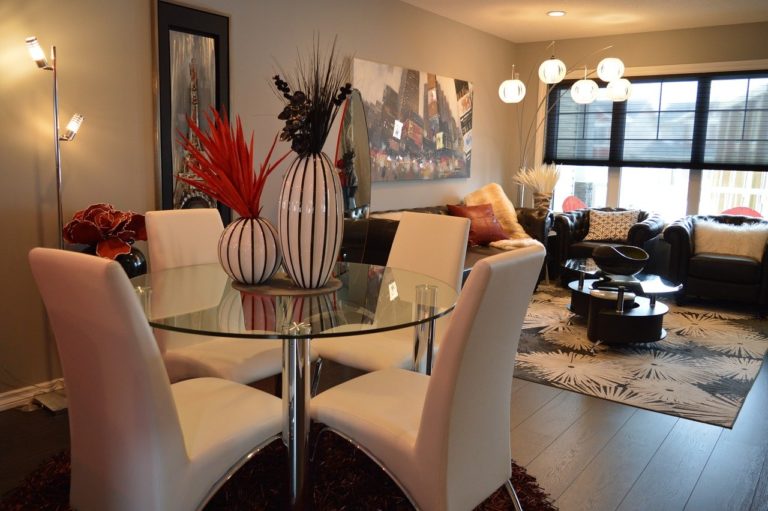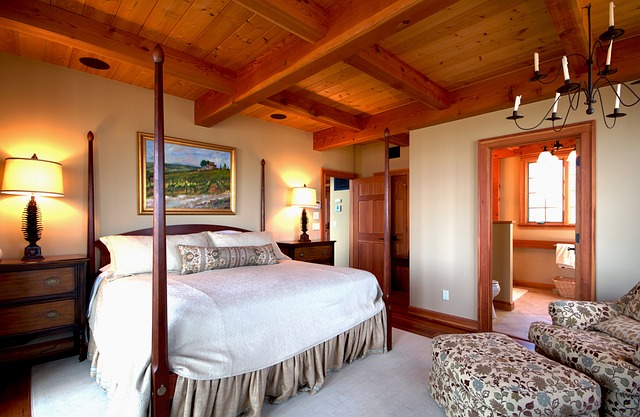As property prices continue to soar, it’s becoming increasingly common for people to downsize and make the most of smaller living spaces. While this can be a great way to save money and simplify your life, it can also present unique challenges when it comes to decorating and designing your home. One of the biggest challenges is how to create the illusion of a larger living space when you’re working with limited square footage.
Fortunately, there are a number of tricks and strategies you can use to make even the smallest homes feel more spacious and welcoming. In this article, we’ll explore ten of the most effective tips for making smaller homes look bigger, from using the right colors and lighting to decluttering and maximizing storage space.
But creating the illusion of a larger living space is about more than just aesthetics. It’s also about creating a functional and practical home that is optimized for your lifestyle and needs. That’s why we’ll also discuss how to streamline your possessions, organize your belongings, and create a peaceful and relaxing living environment that promotes well-being and tranquility.
Whether you’re downsizing to save money or simply want to make your current living space feel more spacious and inviting, the tips and tricks we’ll explore in this article can help you achieve your goals. So let’s dive in and discover the secrets to making smaller homes look and feel bigger, one step at a time.
Declutter and Organize:
One of the most important tricks to making a small home look bigger is to declutter and organize your space. This is especially crucial when dealing with limited square footage. By getting rid of anything you don’t need or use, you can create a more open and spacious feel. A cluttered and disorganized space can make even the largest of homes feel small, so it’s essential to take the time to tidy up and get rid of any excess items.
Start by tackling one room at a time, and sort your belongings into categories such as keep, donate, sell, or toss. Utilize storage solutions such as shelves, baskets, and storage boxes to keep everything organized and tidy. Consider using furniture with built-in storage, such as an ottoman with hidden compartments or a bed with drawers underneath. And remember, keeping surfaces clear can make a space feel more open and spacious.
Choose Light Colours:
Light colours can help to reflect light and make a room feel brighter and more spacious. Pale shades of white, beige, or light grey are great options for walls, floors, and furniture. However, you can also incorporate soft pastel shades or muted tones to add some color and interest to your space. Using a consistent color palette throughout your home can create a cohesive look and feel, and experimenting with textures can add depth and interest.
When selecting colors for your space, it’s essential to consider the amount of natural light the room receives. If your room gets a lot of natural light, you can experiment with darker colors or bold accent walls. However, if your space is lacking in natural light, sticking to light, neutral colors is your best bet.
Use Mirrors:
Mirrors are a fantastic way to create the illusion of more space in a smaller home. They reflect light and make a room feel brighter and more open. A large mirror can make a significant impact in a small space, especially when hung on a wall opposite a window to reflect natural light. Consider creating a mirrored wall or using mirrored furniture such as a coffee table to add some visual interest.
When selecting mirrors for your space, consider the size and placement. A larger mirror can make a room feel bigger, while smaller mirrors can be used to add visual interest. Avoid placing mirrors in areas where they will reflect clutter or dark corners, as this can have the opposite effect and make your space feel smaller.
Get Creative with Lighting:
Lighting can make a small room feel more spacious. Use a combination of different lighting sources to create a layered effect that will make your space feel larger. Whenever possible, use natural light to brighten your space. Keep your windows unobstructed and use light, sheer curtains to let in as much light as possible.
Using a combination of ceiling lights, table lamps, and floor lamps can create a warm and inviting atmosphere. And don’t forget to incorporate dimmer switches to adjust the brightness of your lighting as needed. When selecting lighting for your space, consider the scale of your room. Avoid using oversized lighting fixtures in small spaces, as they can overwhelm the room and make it feel even smaller
Use Multi-Functional Furniture:
In a smaller home, space is at a premium, and multi-functional furniture can be a lifesaver. Look for pieces that serve multiple purposes, such as a sofa bed, storage ottoman, or nesting tables. This can help you maximize your space while still providing all the functionality you need.
For example, a Murphy bed that folds up against the wall when not in use can free up valuable floor space in a bedroom, and a storage ottoman can provide both seating and storage in a living room. And when choosing furniture, opt for pieces with clean lines and a simple design to avoid adding visual clutter to your space
Optimise Your Layout:
The layout of your furniture can have a significant impact on the perceived size of your home. Consider placing your furniture in a way that maximizes flow and function while also creating a sense of openness.
Avoid blocking natural pathways, and position furniture away from walls to create a feeling of depth and dimension. Grouping furniture together can create an intimate and cozy feel, but be sure to leave enough space between pieces to avoid a cluttered look.
If you’re not sure how to arrange your furniture, consider using an online room planner or consulting with an interior designer. They can help you make the most of your space while also creating a beautiful and functional layout.
Embrace Natural Materials:
Incorporating natural materials such as wood, stone, and woven fibers can add warmth and texture to a small space. They create a sense of connection to the outdoors and can make a space feel more inviting and cozy.
Consider using a natural wood accent wall or a stone fireplace to add some visual interest to your space. Incorporating woven textiles such as baskets, rugs, or throw pillows can also add texture and depth. And don’t forget to incorporate natural elements such as plants and flowers to bring life and color to your space.
Maximize Storage:
Storage is crucial in a small home, but it can also be a challenge to incorporate without taking up too much space. Consider using built-in storage solutions such as shelves, cabinets, and drawers to make the most of every inch.
Utilize vertical space by installing shelving units that go all the way up to the ceiling, and invest in furniture pieces that provide hidden storage, such as a storage ottoman or bed with built-in drawers. And don’t forget to declutter regularly to keep your storage areas organized and functional.
Experiment with Scale:
Using a mix of different scales can create a sense of balance and depth in a smaller space. Consider incorporating larger statement pieces, such as a bold piece of artwork or an oversized mirror, to add some drama and interest.
You can also play with scale by incorporating smaller pieces of furniture, such as a low-profile coffee table or a compact armchair. And don’t forget to consider the scale of your decor items as well, such as throw pillows, vases, and lamps. A mix of different scales can create a dynamic and visually interesting space.
Create Zones:
In a small home, it’s essential to create distinct zones for different activities. This can help to create a sense of purpose and organization while also making the space feel larger.
Consider creating a reading nook with a comfortable armchair and a floor lamp, or a workspace with a desk and task lighting. And don’t forget to incorporate a dining area or kitchen island if space allows. By creating distinct zones, you can maximize your space while also creating a sense of functionality and purpose.
In conclusion, making a smaller home feel bigger requires a combination of decluttering, organizing, and strategic design choices. By incorporating light colors, mirrors, and multi-functional furniture, you can create a sense of openness and flow. And by embracing natural materials, maximizing storage, and experimenting with scale, you can add texture and interest to your space. Finally, creating distinct zones can help to maximize your space while also creating a sense of purpose and functionality. By following these tips, you can transform your smaller home into a beautiful and functional space that feels bright, open, and inviting
Conclusion
In conclusion, creating the illusion of a larger living space can be a challenging task, but with the right approach and a bit of creativity, it’s possible to make even the smallest homes feel spacious and welcoming. By following the ten tricks we’ve discussed, you can transform your small living space into a beautiful and functional oasis that is optimized for both style and practicality.
It’s important to remember that maximizing your living space isn’t just about creating a beautiful aesthetic. By decluttering, organizing, and streamlining your possessions, you can also create a more peaceful and serene living environment that promotes relaxation and well-being. This is particularly important in today’s fast-paced world, where our homes serve as our sanctuaries from the stresses of work and everyday life.
In addition to improving your quality of life, optimizing your living space can also have financial benefits. With the housing market becoming increasingly competitive, smaller homes are becoming more popular and sought-after. By implementing the tips we’ve discussed, you can enhance the value of your home and potentially increase its resale value, making it a wise investment for the future.
Ultimately, making the most of a small living space is about embracing creativity, functionality, and style. By incorporating the right colors, materials, and design elements, you can create a home that is both beautiful and functional, no matter the size. So whether you’re looking to downsize or simply want to make your current home feel more spacious and inviting, take the time to explore the possibilities and discover the tricks that work best for you. With a little imagination and a lot of determination, you can turn your small living space into a beautiful and welcoming haven that you’ll be proud to call home.



